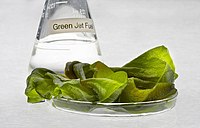
Photo from wikipedia
Torrefaction is a promising pretreatment technology for biomass and its pyrolysis products upgrading. The aim of this study was to investigate the effect of torrefaction on the pyrolysis of seaweed… Click to show full abstract
Torrefaction is a promising pretreatment technology for biomass and its pyrolysis products upgrading. The aim of this study was to investigate the effect of torrefaction on the pyrolysis of seaweed biomass. TG, Py-GC/MS and fixed-bed experiments were used at a series of typical torrefaction temperatures (225 °C, 250 °C, 275 °C and 300 °C) and pyrolysis temperatures (450 °C, 500 °C, and 550 °C). The results showed that increasing of torrefaction temperature led to gradual reduction in moisture content and volatile content due to the precipitation of water and volatile functional groups (OH, NH, CO, C=O, etc.), which resulted in increase of solid products of torrefied seaweed. In addition, the liquid yield showed a promotion at first and then decreased. It also indicated that thermal stability of seaweed became stronger after the pretreatment leading to the initial pyrolysis temperature shifting toward the high temperature section. Meanwhile, the maximum pyrolysis weight loss rate and the total weight loss got a reduction. Moreover, the optimal conditions for maximum bio-oil production were obtained when the temperature of torrefaction was 250 °C at the pyrolysis temperature of 500 °C. Furthermore, the bio-oil under such conditions gave the highest relative content of aromatic hydrocarbons.
Journal Title: Cellulose
Year Published: 2019
Link to full text (if available)
Share on Social Media: Sign Up to like & get
recommendations!